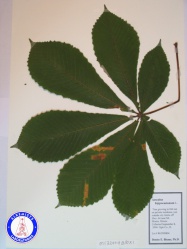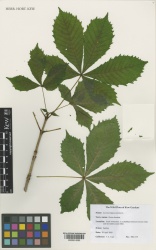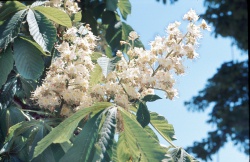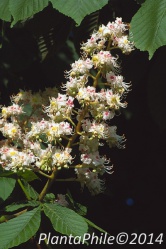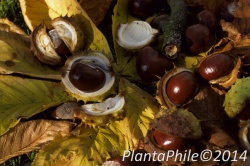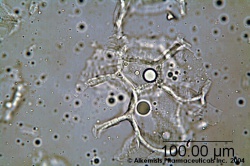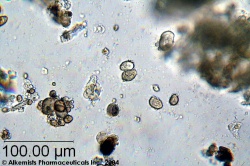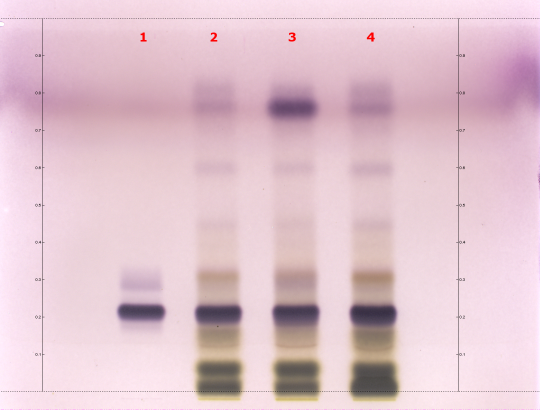Aesculus hippocastanum (seed)
(reference samples correction) |
(add micro characteristics) |
||
| (19 intermediate revisions by 2 users not shown) | |||
| Line 1: | Line 1: | ||
| − | = | + | {{DISPLAYTITLE:''Aesculus hippocastanum'' (seed)}} {{askbox|herb=''Aesculus hippocastanum''}} |
| − | '' | + | =Nomenclature= |
| + | {{nomenclature | binomial=Aesculus hippocastanum | ||
| + | |authority= L. | ||
| + | |family=Hippocastanaceae | ||
| + | |scn=horse chestnut | ||
| + | |syn= | ||
| + | |aka= | ||
| + | |notes=}} | ||
| + | =Botanical Voucher Specimen= | ||
| + | {{Media2 |cat=Voucher | ||
| + | | companyimage=AP-LOGO-Laboratories Crop - Copy.jpg | ||
| + | | companyURL=http://www.alkemist.com | ||
| + | |mainimage=Aesculus hippocastanum MF32004BMX1 A1299.jpg | ||
| + | |source=Botanical Voucher Specimen Library, Alkemists Laboratories | ||
| + | | companyimage2=Kewlogo.gif | ||
| + | | companyURL2=http://specimens.kew.org/herbarium/K000914265 | ||
| + | | image2=Aesculus_hippocastanum_Kew_imageBarcode=K000914265_517072.jpg | ||
| + | | source2=Royal Botanic Gardens, Kew. | ||
| − | + | }} | |
| − | |||
| − | |||
| − | + | =Organoleptic Characteristics= | |
| − | = | + | {| border=1 |
| + | | | ||
| + | {{Organolepsy | source=United States Dispensatory (1918) | ||
| + | | description="...bitter, disagreeable taste..." | ||
| + | }} | ||
| + | |} | ||
| + | =Macroscopic Characteristics= | ||
| + | {| border=1 | ||
| + | | | ||
| + | {{Macroscopy | source=American Medicinal Plants of Commercial Importance (1930) | ||
| + | | description=The horsechestnut is a rather large tree, usually reaching 40 feet or more in height. The large leaves are composed of five to seven leaflets from 4 to 8 inches long, pointed, and broader at the top than at the base. In June it produces handsome flower clusters sometimes a foot in length, consisting of large white flowers spotted with yellow and red. The fruit is round and prickly and contains a large shining brown nut. | ||
| + | }} | ||
| + | {{Media3 | cat=Macroscopy | ||
| + | | companyimage= TropicosLogo.gif | ||
| + | | companyURL=http://www.tropicos.org/Image/35153 | ||
| + | | mainimage=Aesculus hippocastanum Tropicos 35153.jpg | ||
| + | | source=Tropicos.org. Missouri Botanical Garden. 05 Aug 2013 | ||
| − | + | | source2=PlantaPhile | |
| − | | | + | | image2=PlantaPhile - 656.jpg |
| − | | | + | | companyimage2=PlantaPhile logo.jpg |
| − | | | + | | companyURL2=http://plantaphile.com/ |
| − | + | ||
| − | + | ||
| − | + | ||
| − | = | + | | source3=PlantaPhile |
| + | | image3=PlantaPhile - 1796.jpg | ||
| + | | companyimage3=PlantaPhile logo.jpg | ||
| + | | companyURL3=http://plantaphile.com/ | ||
| − | |||
| − | |||
| − | |||
| − | |||
| − | |||
| − | |||
| − | |||
| − | |||
| − | |||
| }} | | }} | ||
| + | |} | ||
| + | =Microscopic Characteristics= | ||
| + | {| border=1 | ||
| + | | | ||
| + | {{Microscopy | source=Winton, A. (1916) Microscopy of vegetable foods, 2nd ed. | ||
| + | | description=Especially noticable [under the microscope] are the grotesque shapes [of horse-chestnut starch]. Quite often two or more grains are united to form irregularly shaped aggregates. Suppantschitsch rightly notes that the individuals of these aggregates are so closely consolidated that they can be distinguished only with the aid of the polariscope. Among the grains are numerous pear-shaped reniform and irregularly swollen forms. The large grains are mostly 20 to 30 microns long, but occasionally reach 40 microns. The small grains are often scarcely measurable. [The hilium] is distinct and situated at the broader end. A longitudinal cleft passing through the hilium is sometimes present. Rings are indistinct. Polarization crosses are distinct in the large grains. A play of colors is obtained with the selenite plate. | ||
| + | }} | ||
| − | = | + | {{Media2 |cat=Microscopy |companyimage=AP-LOGO-Laboratories Crop - Copy.jpg |
| + | | companyURL=http://www.alkemist.com | ||
| + | |companyimage2=AP-LOGO-Laboratories Crop - Copy.jpg | ||
| + | | companyURL2=http://www.alkemist.com | ||
| + | |mainimage=Aesculus_hippocastanum_L._-Hippocastanaceae--1.jpg | ||
| + | |caption1=Large thin-walled parenchyma showing intercellular spaces of Aesculus hippocastanum seed viewed at 400x with Acidified Chloral Hydrate Solution. | ||
| + | |source=Elan M. Sudberg, Alkemist Laboratories | ||
| + | |image2=Aesculus_hippocastanum_L._-Hippocastanaceae--2.jpg | ||
| + | |caption2=Starch granules showing well marked cleft of Aesculus hippocastanum seed viewed at 400x with Acidified Chloral Hydrate Solution. | ||
| + | |source2=Elan M. Sudberg, Alkemist Laboratories }} | ||
| + | |} | ||
| + | =High Performance Thin Layer Chromatographic Identification= | ||
{{HPTLC | source=CAMAG HPTLC | {{HPTLC | source=CAMAG HPTLC | ||
| Line 60: | Line 100: | ||
| − | = | + | =Supplementary Information= |
| + | |||
| + | =Sources= | ||
| + | |||
| + | <references /> | ||
Latest revision as of 17:50, 24 June 2015
Contents |
Nomenclature
Aesculus hippocastanum L. Hippocastanaceae
Standardized common name (English): horse chestnut
Botanical Voucher Specimen
 |
 |
|
|
|
Organoleptic Characteristics
|
Macroscopic Characteristics
|
Microscopic Characteristics
|
High Performance Thin Layer Chromatographic Identification
|
Horse Chestnut (seed) (Aesculus hippocastanum) Lane Assignments Lanes, from left to right (Track, Volume, Sample):
Reference Sample(s) Reference: Dissolve 15 mg of escin in 3 mL of methanol. Stationary Phase Stationary phase, i.e. Silica gel 60, F254 Mobile Phase 1-butanol, water, glacial acetic acid 50:40:10 (v/v/v) Sample Preparation Method Sample: Mix 1 g of powdered sample with 10 mL of ethanol-water (7:3), heat on a steam bath for 10 minutes, then centrifuge or filter the solutions and use the supernatants / filtrates as test solutions Anisaldehyde Reagent Preparation: 1mL anisaldehyde reagent, 20mL acetic acid 99%, 170mL methanol, 10ml sulfuric acid 95%-97% Detection Method Anisaldehyde Reagent Use: Dip (time 0, speed 5), heat at 100°C for 4 min Other Notes Compare result under white RT with reference images in Image Comparison Viewer. The fingerprint of the test solution is similar to that of the corresponding botanical reference sample. Additional weak zones may be present. A. hippocastanum Identification: Above the zone due to escin the chromatogram shows several narrow, brown to brownish-red zones that are less intense than the zone corresponding to escin.
|
Supplementary Information
Sources
- ↑ Botanical Voucher Specimen Library, Alkemists Laboratories http://www.alkemist.com
- ↑ Royal Botanic Gardens, Kew. http://specimens.kew.org/herbarium/K000914265
- ↑ United States Dispensatory (1918)
- ↑ American Medicinal Plants of Commercial Importance (1930)
- ↑ Tropicos.org. Missouri Botanical Garden. 05 Aug 2013 http://www.tropicos.org/Image/35153
- ↑ PlantaPhile http://plantaphile.com/
- ↑ PlantaPhile http://plantaphile.com/
- ↑ Winton, A. (1916) Microscopy of vegetable foods, 2nd ed.
- ↑ Elan M. Sudberg, Alkemist Laboratories http://www.alkemist.com
- ↑ Elan M. Sudberg, Alkemist Laboratories http://www.alkemist.com
- ↑ CAMAG HPTLC http://www.camag.com/index.php
- Botanical
- Hippocastanaceae
- Media
- Voucher
- Botanical Voucher Specimen Library, Alkemists Laboratories
- Royal Botanic Gardens, Kew.
- Organolepsy
- United States Dispensatory (1918)
- Macroscopy
- American Medicinal Plants of Commercial Importance (1930)
- Tropicos.org. Missouri Botanical Garden. 05 Aug 2013
- PlantaPhile
- Microscopy
- Winton, A. (1916) Microscopy of vegetable foods, 2nd ed.
- Elan M. Sudberg, Alkemist Laboratories
- HPTLC
- CAMAG HPTLC
